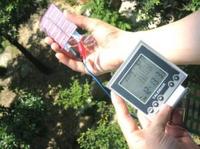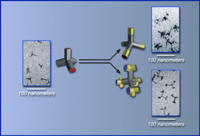Which is the better solar cell, a cheap one or an efficient one?
The topic is becoming important, as Nobel Laureate Alan Heeger of UC Santa Barbara and Korean scientists at the Gwangju Institute roll out a new line of plastic solar cells.
The new cells use two multi-layered sheets of plastic to pick up a wider range of light bandwidths. The claim is they can convert 6.5% of the energy they receive into energy, at a cost of just 10 cents a watt.
There is a difference of opinion concerning how efficient they can make plastic solar cells, but the most key for me is the cells can be produced with a method similar to printing. Current solar cells require manufacturing processes common to silicon computer chips. They also use similar raw materials so chipmakers wind up competing with solar cell makers much as bakers must now compete with ethanol producers.
These are great business questions, which will be fun to digest. As you can see from the illustration which comes from Dr. Heeger, the plastic cell can easily power handheld devices which now have to be charged, or carry replaceable batteries. (I can’t wait for an iPod that runs on solar cells, can you?)
The answer to the question above is, thus, it depends. There are many different markets for solar cells and panels:
- Very low power devices, like calculators and watches, can already run on solar cells.
- Off the grid applications like street signs or emergency phones exist.
- Low power devices currently requiring batteries or recharging, like iPods, are next.
- Back-up and auxiliary power for homes and offices, like those of Google, are another market.
- Mass market power replacing coal and other hydrocarbons, which can be sited off-the-grid to produce hydrogen for cars, is yet another market.
The solar cell technology which makes sense may be completely different depending on your goals and your market.
There are other ways to make solar cells. Michael Wong at Rice used a chemical process,
with one of the ingredients being common to shampoos. He was producing
"cadmium-selenide quantum dots," four-legged molecules that can be
highly efficient in turning light into electricity. (This picture of quantum dot branching comes from Voyle.Net. The article describes how cadmium-selenide dots can be "extended" using cadmium telluride into more complex structures.)
Which leads to the key question. The key variables in estimating the
value of solar cells are the area you need in order to get a yield and
the inherent cost of the cell. Is a 5% efficient cell which costs 10 cents better
than a 20% efficient cell which costs $1?
The question is not important today, because the space available for
solar panels is still theoretically unlimited, so in the short run the
key is to get the costs down so more people install them. But at some
point efficiency also becomes a question, as does the cost of
retrofitting, say, a quantum dot cell into a system designed for
plastic.
These are going to be big business questions 10 years from now, so how about we ask them now?












This is the kind of question to which there is no right answer. For some applications efficiency is king is there are specific space and power requirements (eg solar powered iPod). For other applications space and power requirements are far more flexible (eg solar panels on new construction to offset electrical grid demand) and cost will be the main driver of adoption.
This is the kind of question to which there is no right answer. For some applications efficiency is king is there are specific space and power requirements (eg solar powered iPod). For other applications space and power requirements are far more flexible (eg solar panels on new construction to offset electrical grid demand) and cost will be the main driver of adoption.